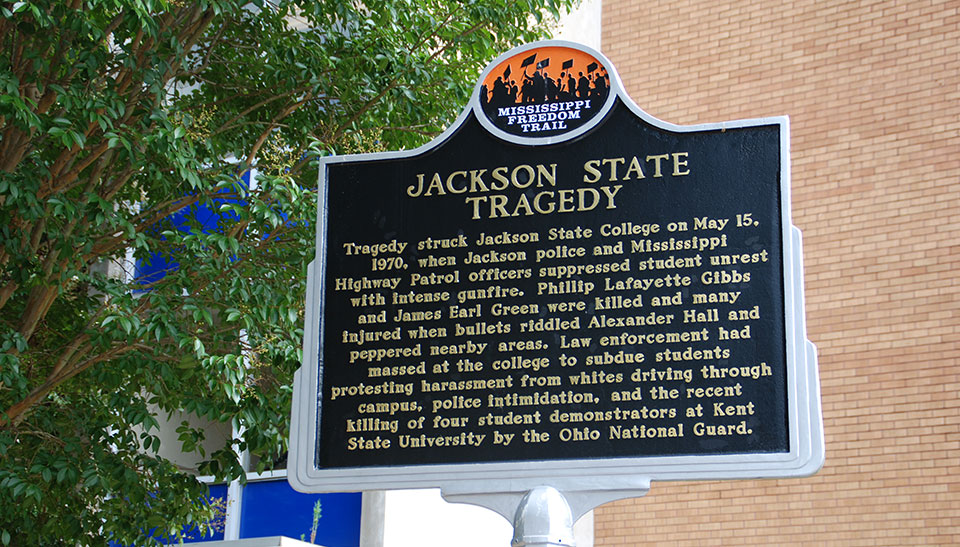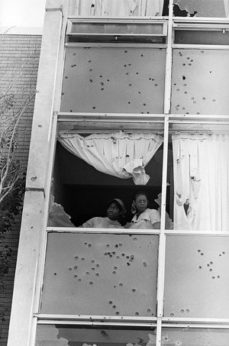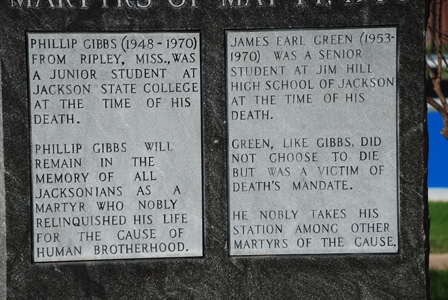
The Jackson State killings occurred on Friday, May 15, 1970, at Jackson State College, a historically Black college (now Jackson State University) in Jackson, Mississippi, the state capital and its largest city.

Two students at Jackson State peer from a window that was shot out by police on campus in May 1970. Jack Thornell/AP
On May 14, 1970, a group of student protesters against the Vietnam War, specifically the U.S. invasion of Cambodia, were confronted by city and state police. Shortly after midnight, the police opened fire, killing two students and injuring twelve. The event happened only 11 days after National Guardsmen killed four students in similar protests at Kent State University in Ohio, which had first captured national attention. College campuses across the country were in turmoil over the fresh expansion of the hated war.
A group of around a hundred African-American students had gathered on Lynch Street, a major thoroughfare that divided the campus and linked West Jackson to downtown which was a well known site for racial intimidation and harassment by white motorists. A rumor spread that Fayette, Miss. Mayor Charles Evers (brother of slain civil rights activist Medgar Evers) and his wife had been shot and killed. By around 9:30 p.m. the students had started fires, thrown rocks at motorists, and overturned vehicles, including a large truck. Firefighters at the scene quickly requested police support.
The police responded in force. At least 75 Jackson police units from the city and the Mississippi Highway Patrol attempted to control the crowd while the firemen extinguished the fires. After the firefighters had left, shortly before midnight, the police moved to disperse the crowd then gathered in front of Alexander Hall, a five-story women’s dormitory.
Advancing to within 50-100 feet of the crowd, at roughly 12:05 a.m. on May 15, officers opened fire on the dormitory. Authorities claimed they saw a sniper on one of the building’s upper floors but an FBI search for evidence of sniper fire was negative. At least 140 shots – some estimate more than 460 – were fired by a reported 40 state highway patrolmen using shotguns from 30 to 50 feet. Every window on the side of the building facing Lynch Street was shattered.
 Phillip Lafayette Gibbs, 21, a junior pre-law major and father of an 18 month-old son, and James Earl Green, 17, a senior at nearby Jim Hill High School who was walking home from work at a local grocery store when he stopped to watch the action, were killed; 12 others were wounded. But ambulances were not called until after the officers picked up their shell casings, a U.S. Senate probe conducted by Sens. Walter Mondale and Birch Bayh later revealed.
Phillip Lafayette Gibbs, 21, a junior pre-law major and father of an 18 month-old son, and James Earl Green, 17, a senior at nearby Jim Hill High School who was walking home from work at a local grocery store when he stopped to watch the action, were killed; 12 others were wounded. But ambulances were not called until after the officers picked up their shell casings, a U.S. Senate probe conducted by Sens. Walter Mondale and Birch Bayh later revealed.
There were no arrests in connection with the deaths at Jackson State, although the President’s Commission on Campus Unrest concluded “that the 28-second fusillade from police officers was an unreasonable, unjustified overreaction…A broad barrage of gunfire in response to reported and unconfirmed sniper fire is never warranted.”
The university has memorialized the shootings by naming the area the Gibbs-Green Plaza. A large stone monument in front of Alexander Hall near the plaza honors the two victims.
According to an NPR essay on the 40th anniversary of the killings, “The event continues to leave a mark on the university. Even today, passers-by can see the bullet holes in the women’s dorm… All Jackson State students learn about the shooting in a mandatory orientation class, and professors evoke the event as a teaching tool. C. Liegh McInnis, who teaches creative writing and world literature at Jackson State, says the story of the shooting is integrated into the curriculum of several liberal arts departments.”
Adapted from The Biographical Dictionary of Black Americans by Rachel Krantz and Elizabeth A.Ryan; National Public Radio (May 3, 2010); and Wikipedia.
Photo: Jackson memorial

MOST POPULAR TODAY

Zionist organizations leading campaign to stop ceasefire resolutions in D.C. area

High Court essentially bans demonstrations, freedom of assembly in Deep South

Communist Karol Cariola elected president of Chile’s legislature

U.S. imperialism’s ‘ironclad’ support for Israel increases fascist danger at home







Comments